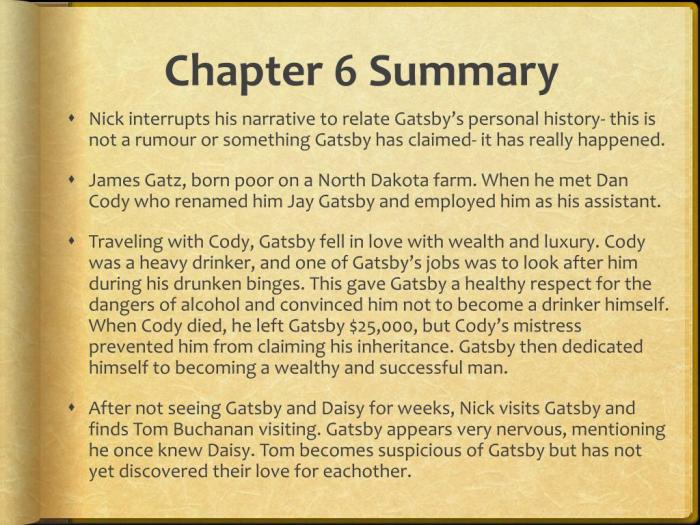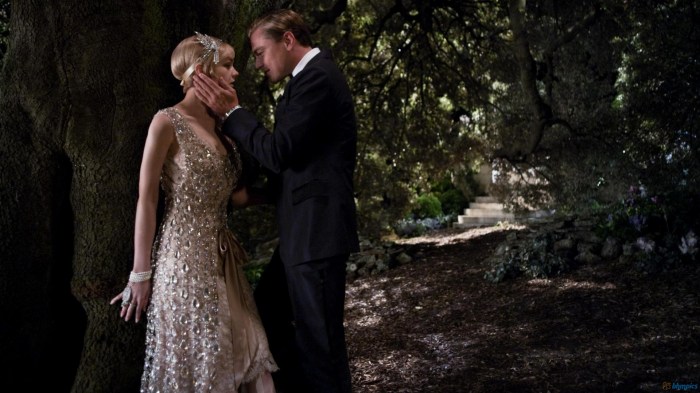Chapter 6 the great gatsby questions – Embarking on Chapter 6 of F. Scott Fitzgerald’s masterpiece, The Great Gatsby, we delve into a realm of intricate relationships, multifaceted characters, and the elusive nature of the American Dream. This chapter unveils the complexities of Gatsby’s unwavering love for Daisy, Daisy’s enigmatic character, and the significant role of Tom Buchanan in the unfolding drama.
Through an in-depth exploration of symbolism, character analysis, and thematic undercurrents, we unravel the profound impact of Gatsby’s unrequited love on his actions and aspirations. We examine Daisy’s motivations and the ways in which her character contributes to the tragic trajectory of the novel.
Daisy’s Character

Daisy Buchanan is a complex and enigmatic character in F. Scott Fitzgerald’s The Great Gatsby. She is both alluring and aloof, a woman who both attracts and repels the novel’s protagonist, Jay Gatsby. Daisy’s motivations are often unclear, and her actions are often driven by a combination of desire, fear, and social convention.
Daisy’s Attractiveness and Repulsiveness to Gatsby
Daisy is initially drawn to Gatsby because he represents everything that her husband, Tom Buchanan, is not. Gatsby is wealthy, charming, and attentive, and he seems to offer Daisy a life of excitement and adventure. However, Daisy is also repelled by Gatsby’s lack of refinement and his association with the criminal underworld.
She ultimately chooses to stay with Tom, despite her feelings for Gatsby, because she values social stability and security over passion and romance.
Daisy’s Contribution to the Novel’s Tragic Ending
Daisy’s character plays a significant role in the novel’s tragic ending. Her indecisiveness and her inability to commit to either Gatsby or Tom lead to a series of events that ultimately culminate in Gatsby’s death. Daisy’s actions are driven by her own selfish desires, and she is ultimately unable to escape the consequences of her choices.
Tom Buchanan’s Role

Tom Buchanan, the wealthy and arrogant husband of Daisy, plays a pivotal role in the tragic events that unfold in The Great Gatsby. His character and actions significantly contribute to the novel’s central conflict and themes.
Tom’s Character and Relationship with Daisy
Tom is a physically imposing man, described as “a man with a hard mouth and a soft voice.” He is a wealthy aristocrat with a sense of entitlement and a deep-seated prejudice against those he deems inferior. Tom’s relationship with Daisy is characterized by his possessiveness and emotional abuse.
He is consumed by jealousy and suspicion, constantly monitoring Daisy’s movements and questioning her loyalty.
Tom’s Actions and the Conflict
Tom’s actions are a major catalyst for the novel’s conflict. His refusal to grant Daisy a divorce, despite her unhappiness in their marriage, sets the stage for the tragedy. His arrogant dismissal of Gatsby’s love for Daisy fuels Gatsby’s obsession and leads to his downfall.
Furthermore, Tom’s carelessness and recklessness contribute to the tragic death of Myrtle Wilson.
Significance of Tom’s Wealth and Social Status
Tom’s wealth and social status play a significant role in the story. His wealth allows him to maintain a luxurious lifestyle and exert influence over others. His social status gives him a sense of superiority and entitlement. However, these advantages also contribute to his downfall, as they blind him to the true nature of his own character and the consequences of his actions.
The Symbolism of the Green Light

The green light at the end of Daisy’s dock is a powerful symbol that represents Gatsby’s hopes and dreams. It is a beacon of hope that keeps him going, even when things are tough. The green light also represents the past, and Gatsby’s longing to recapture the love he had with Daisy.
The Green Light as a Symbol of Hope
For Gatsby, the green light is a symbol of hope. It represents his belief that he can win Daisy back and that they can have a happy life together. The green light keeps Gatsby going, even when things are tough.
It gives him the strength to keep fighting for what he wants.
The Green Light as a Symbol of the Past
The green light is also a symbol of the past. It represents Gatsby’s longing to recapture the love he had with Daisy. Gatsby believes that if he can just get Daisy back, then everything will be perfect. However, the green light is also a reminder of the fact that the past cannot be changed.
Gatsby can never truly go back to the way things were with Daisy.
The Green Light as a Foreshadowing of the Novel’s Tragic Ending, Chapter 6 the great gatsby questions
The green light foreshadows the novel’s tragic ending. It is a reminder that Gatsby’s dream of winning Daisy back is ultimately doomed to failure. The green light is a symbol of hope, but it is also a symbol of the past.
Gatsby cannot escape the past, and he cannot change the fact that he and Daisy are not meant to be together.
The Theme of the American Dream: Chapter 6 The Great Gatsby Questions
The American Dream, a central theme in F. Scott Fitzgerald’s The Great Gatsby, embodies the aspirations and ideals of a better life for individuals. This dream encompasses the pursuit of wealth, success, and social mobility, often symbolized by the acquisition of material possessions and status.
Gatsby’s Embodiment of the American Dream
Jay Gatsby epitomizes the American Dream in his relentless pursuit of wealth and status. Born into poverty, Gatsby reinvents himself as a wealthy and enigmatic millionaire, believing that material success will win him the love of his life, Daisy Buchanan.
His lavish parties and extravagant lifestyle represent his aspiration to transcend his humble beginnings and achieve the pinnacle of American society.
The Critique of the American Dream
While Gatsby embodies the allure of the American Dream, the novel also critiques its limitations and potential pitfalls. The pursuit of wealth and status often comes at the expense of genuine relationships and personal fulfillment. Gatsby’s obsession with Daisy blinds him to the true nature of their past and the impossibility of recapturing it.
His dream ultimately crumbles, leaving behind a legacy of shattered hopes and disillusionment.
The Corrupting Influence of Wealth
The novel exposes the corrupting influence of wealth on individuals and society. The characters of Tom and Daisy Buchanan exemplify the superficiality and moral decay that can accompany material success. Their wealth insulates them from the consequences of their actions, fostering a sense of entitlement and disregard for others.
The Elusive Nature of the Dream
The Great Gatsbyalso highlights the elusive nature of the American Dream. Gatsby’s relentless pursuit of Daisy symbolizes the unattainability of a perfect past and the futility of trying to recreate it. The novel suggests that the true American Dream lies not in material possessions or social status, but in the pursuit of genuine connections, meaningful experiences, and the acceptance of life’s complexities.
Top FAQs
What is the significance of the green light at the end of Daisy’s dock?
The green light symbolizes Gatsby’s hopes and dreams, representing his unwavering belief in the possibility of rekindling his love with Daisy.
How does Tom Buchanan’s character contribute to the conflict in the novel?
Tom’s arrogant and possessive nature fuels his rivalry with Gatsby and creates a barrier between Daisy and her former lover.
In what ways does Daisy’s character contribute to the tragic ending of the novel?
Daisy’s indecisiveness and desire for both stability and excitement ultimately lead to her inability to fully commit to either Gatsby or Tom, contributing to the tragic outcome.